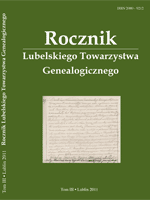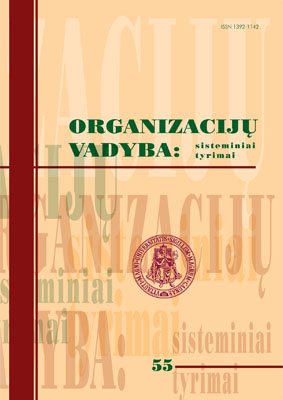
Rain, rainbow / Springs in Edenkoben (two poems)
Eső, szivárvány / Tavasz Edenkobenban (két vers)
Keywords: Hungarian - poetry
More...
Keywords: Hungarian - poetry
More...
Keywords: History of Poland 16th century; Wieluń; professional groups; religious groups;
Wieluń in the first half of the 16th century was a middle-sized town but could be considered a big one in Greater Poland. The described town society had to live in the finest period in Wieluń’s history, without wars and natural disasters, but in a convenient location on trade routes. The town was a conglomerate of various social, professional, religious and informal groups. Along with natural divisions resulting from the place of residence (within the town walls and outside), profession or identity there also existed differences in terms of their class. New burgesses came from the very bourgeoisie, but also from peasantry and gentry, though mainly poor. The society of Wieluń could also be divided in a considerably lesser degree on account of their ethnic affiliation and professed religion, Jews and Protestants infrequently settled there. The role of a keystone, the element binding together bourgeoisie varying in terms of their social background and economic status was best performed on religious plane, although it was far from equality even there. However, all of them met in the parish church (and other churches), belonged to the same fraternities, gave donations for the building of the same altars and finally were buried at the same cemeteries.
More...
Keywords: History of Poland 16th century; genealogy; Żółkiewski Stanisław; Żółkiewski family;
It could seem that the history of the Żółkiewskis, one of the most famous and distinguished families in the Commonwealth at the turn of the 16th and 17th century, should be very well known and documented. In fact, with regard to political and especially military activity of the chancellor and the great Crown hetman Stanisław and partly of his father’s we know quite a lot. However, surprisingly little is known about the hetman’s ancestors – the Żółkiewskis from Żółkiew (current name Żółkiewka) near Krasnystaw. Rather laconic and often misleading information contained in Paprocki’s or Niesiecki’s armorials was without much criticism repeated by historians. Meanwhile a thorough library research of court registers from Chełm and Krasnystaw led to many new findings, shedding a new light on their family connections. It can be inferred from this source that the grandfather of hetman Stanisław Żółkiewski was in fact not Mikołaj, the alleged Bełżec voivod, as armorists would have it, but Stanisław, Khorunzhyi of Chełm and Krasnystaw, succamerarius of Bełżec and a judge of Chełm, who died in 1525. It was also possible to capture the family connections and activity of hetman’s paternal uncles (Jan, Tomasz, Kasper and Marcelin) and cousins (Paweł, Andrzej, Jan, Tomasz and Idzi) in the Chełm Land. An attempt was also made at explaining the fact of the co-occurrence of two Żółkiewski families, with different coats of arms – Lubicz and Bończa, and it was possible to trace the origins of the latter ones to the Radwański family, having their parts of land in Żółkiew, who with time started using the place-derived name as well.
More...
Keywords: History of Poland 15th - 17th century; Cracow; brewing industry; women;
According to an unanimous opinion of many researchers, the period from the half of the 15th until the beginning of the 17th century is “the beer golden age”. Beer was a commonly used drink, and malt and beer brewing industry had a considerable role for the economy. In the half of the 16th century almost 150 breweries were run in Kraków, whose contemporaneous population is estimated to be circa 20000 people. There was one brewery to about 140 inhabitants. Many women could be found among the owners of the breweries. Kraków guild statutes do not directly specify the rules concerning company take-overs made by women, it is obvious, however, that they could only be run by widows. Similar rules were in effect in all Polish towns. About 10 percent of breweries in Kraków were run by women, and the most active ones gained considerable independence. These women accumulated substantial wealth, bought and sold properties freely, paid for their children’s education, invested in the development of their companies. Women did not participate in the production works in person, hired brewers were employed for this purpose. An average production in breweries run by women was usually higher than this of their male equivalents. It was especially evident in the moments of temporary falls of production, as well as during more serious crises. Although almost 40 percent of women ended their professional career in a time shorter than a year, a considerable part of women managed to stay longer, sometimes even a few decades, in the brewing industry.
More...
Keywords: History of Poland 12th-13th century; genealogy; Casimir II the Just duke; Leszek the White duke; Opatów
The aim of this article is to present a characteristics of two documents, the first from 1189 and the second one dating back to the year 1206. The conducted analysis shows that the publishing place of the two documents was Opatów. The first from the mentioned documents was issued by the duke Casimir II the Just, whereas the second one by his son Leszek the White. The work is an attempt at analyzing testamentation included in both documents in order to study the genealogy of the enlisted witnesses.
More...
Keywords: History of Poland 17th century; genealogy; Szornel Jerzy; Dołęga coat of arms; Lublin; Popkowice;
Jerzy Szornel (1600-1677) was a son of Jan Szornel, lieutenant-colonel in the king’s army, and Zofia Wołczkówna. He received a sound education in the Lublin Jesuit College, at the University of Kraków, in a Jesuit College in Kalisz, at the Zamojski Academy, and later in the thirties he studied law in Padua. In 1634 he came back to his homeland, and like his father he bound up his career with the Zamoyski family, holding among others the office of advisor in the Zamojski Academy, a judge in the Zamość Court of Appeal, administrator of the lands in the Zamoyski entail. In 1653 he was elected the voivodship tax collector during a regional diet. Holding the office of a junior judge in Lublin in the years 1653-1658, and later of iudex terrestris, he became a well known person among the gentry. He was appointed to the position of the Speaker of the regional diet several times, an MP for the Sejm, a gentry representative from the Lublin voivodship. He showed skills and an interest in literature and science. Because of his numerous duties he resided mostly in Zamość and Lublin, lived in his inheritance in Skorczyce and in Wilkołaz leased from Zamoyski entail. Jerzy was married to Zofia Gano and after her death with Anna Michowska. In 1667 he founded Holy Trinity church in his inherited estate Popkowice. His will was made in Popkowice estate in July 1667. The widow was suspected by the brothers of the deceased of forging the testament and they formulated a protest in which they tried to prove their rights. Jerzy Szornel was buried in the vault of the Jesuit church in Lublin. His last will contains a lot of information disclosing a fragment of the testator’s reality, and the objection to the testament casts light on the family relationships and inheritance matters.
More...
Keywords: History of Poland 16th - 19th century; genealogy; church registers; Lublin Bridgettines;
The entries made from the end of the 16th century in Church Registers are a proof of how not only the language used to describe for a description of death, but also the mentality of nunnery life were changing in the course of subsequent centuries. Death-related rhetorics applied in the discussed entries was in the beginning strictly informational in nature. The influence of literary conventions of the Baroque caused the entries about the nuns’ deaths to have a more poetic, moderately embellished character. Thus demise was seen as gaining eternal reward for living according to God’s commandments, as an introduction to heavenly feast. The entries dating back to the last decades of the 18th century contain echoes of the search for consolation and a stable spiritual basis in the face of changeable worldly reality. The didactic character of the excerpts from Church Registers from the 19th century places death in the context of the path to sanctity.
More...
Keywords: Russia 18th-20th century; genealogy; Adlerberg family;
The article presents the history of a Swedish gentry family Adlerberg. The analysis of the family genealogy was based on rich source materials: archival sources stored in Russian National Historical Archive in Sankt Petersburg, printed sources and available German and Russian field literature. The author presents the history of Adlerbergs from the very beginnings, i.e. from the times of service for the Swedish kings, through the confirmation of their nobilitation by the Russian rulers, until the moment of the fall of the Romanov empire. Adlerbergs, as many similar gentry families of Swedish origin inhabiting Livonia, took various positions in the Russian army or in different offices of general and specialised administration. The presence of Adlerbergs could also be noticed in the area of Congress Poland of unifying era. The family inscribes into the landscape of the gentry world of the 18th and 19th century Russia.
More...
Keywords: History of Poland 19th century; genealogy; Lublin region; Zaklików;
The Tsar ukase from 7th June 1846 imposed on landowners a duty of making out household register charts, i. e. lists of obligations and rights of the rural inhabitants of villages and towns, which turned out to be exceptionally detailed in comparison to the old ones. The legislator assumed that writing down ”remunerations, obligations and duties” would be the first step in the process of liquidating additional payments and forced renting. A description of households included in the chart contained a few basic elements. Apart from the information which using the present nomenclature could be called personal data (name and surname, profession, house number), the chart contained 6 categories: “farmers” wages and obligations towards the landowner, Church institutions, county, government and Insurance Head Office. Unfortunately, the procedure of preparing the chart as well as the process of verification opened a way to giving false information. Regardless of the fact this type of sources is highly valued by historians for research opportunities . The chart presented in the article contains the data concerning inhabitants of Zaklików, a typical small town in the Lublin Region, where apart from crafts farming was the basis of existence. The presented source has additional significance for learning about social and professional structure formed by the inhabitants of Zaklików, because during World War II the files of register office were destroyed.
More...
review of: Wieluński słownik biograficzny, pod red. Z. Szczerbik, Z. Włodarczyk, t. 1, Wieluń 2012, ss. 144
More...
Sprawozdanie z III Seminarium Genealogicznego Nasze korzenie. Wokół poszukiwań genealogicznych rodzin pomorskich, Gdynia, 8 października 2011 r.
More...





Keywords: the New Civil Code; works of intellectual creation; copyright; minor child
Works of intellectual creation, whether they belong to the category of those protected by copyright law (literary, artistic or scientific works), whether they belong to the industrial applicability creations (inventions, innovations, utility models, designs and patterns, topographies of semiconductor products, etc.), are, without exception, the product of the human intellectual activity. In other words, they are exclusively created by the individual or the individuals. It is a consequence of the fact that only the human being enjoys the intellectual and volitional capacity, the ability to consciously direct its activity and inactivity in relation to interests animating him. On the other hand, only the human individual possesses intelligence, rationality, talent, vocation, artistic skills required in the act of creation. By way of consequence, only the human being, including the minor child, the person under judicial disability or the lunatic may hold authorship of an intellectual creation and, therefore, they may acquire rights and obligations arising from the act of creation. Secondly, it should be noted that the laws protecting intellectual creations, both in the sphere of copyright and in the industrial property one make no distinction as to individuals human creators of intellectual works in terms of their legal capacity. In other words, the authorship of such creations can acquire even the minor child, although he/she does not have full or restricted legal capacity.
More...Keywords: remuneration; performers; broadcasting; phonograms
The institution of copyright and related rights, as regulated in our system by Law nr. 8/1996, deals with the protection of literary, artistic and scientific works and their creators. By a definition that has a tradition in our doctrine, the legal institution of copyright (generally speaking) means all the legal rules governing social relations that arise from the creation, publication and use of literary, artistic or scientific works.
More...
Keywords: ES bendroji rinka; koncepcijos analizė; ekonomikos augimas; Lietuvos smulkus ir vidutinis verslas; vizijos modelis; EU common market; concept analysis; economic growth; small and mediumsized business in Lithuania; development; model of vision
The article analyzes the relationship between the EU common market influence on small and medium-sized business and its development in Lithuania. The article presents a created structural model/scheme of economic integration preconditions, in which four freedoms and two economic integration possibilities or failures are distinguished. According to this model the dependence on this influence was analyzed and a model of vision prepared, showing the planning process for the small and medium-sized business in Lithuania under the existing economic crisis conditions. Straipsnyje analizuojamas ryšys tarp ES bendrosios rinkos poveikio ir smulkaus bei vidutinio verslo padėties Lietuvoje. Sudarytas keturių laisvių ir dviejų ekonominės integracijos galimybių ar nesėkmių struktūrinis modelis. Pagal šį modelį, atlikus smulkaus ir vidutinio verslo Lietuvoje padėties analizę, pateiktas vizijos modelis: jis pateikia smulkaus ir vidutinio verslo išlikimo galimybes ekonominės krizės sąlygomis nacionalinėje rinkoje bei nurodo orientavimosi į ES bendrąją rinką gaires.
More...